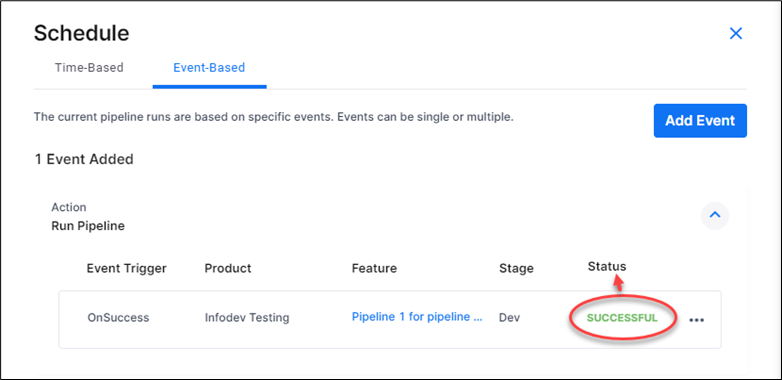Data Pipeline Chaining
Data Pipeline Studio provides the ability of pipeline chaining. Using this feature, you can automate the run of multiple pipelines based on a specific event of other pipelines. You can schedule pipeline run of one pipeline based on the following events of another pipeline:
-
On successful completion of a pipeline run
-
On failure of pipeline run
-
On timeout of pipeline run
-
When the pipeline goes into the wait state
-
On initiation of pipeline run
-
On completion of pipeline run
Use cases
Let us discuss some use cases where pipeline chaining can be used:
-
When multiple pipelines need to run in a specific sequence
In this scenario, you may have pipelines A, B, and C. You may want pipeline B to run on completion of run of pipeline A. Then you may want pipeline C to be triggered on successful completion of pipeline B.
-
When you have pipelines as a fallback for other pipelines
In the scenario, you may have pipelines A, B, C, and D.
You may want to trigger pipeline B on successful run of pipeline A, run pipeline D on timeout of pipeline C, or run pipeline B if pipeline A goes into wait mode.
To create a chained pipeline
-
Create pipeline 1 and pipeline 2. Let us assume that pipeline 2 has a dependency that the pipeline is triggered on successful run of pipeline 1.
-
On the home page of Data Pipeline Studio, open pipeline 2 and click the ellipsis (...). Then click Schedule Run.
-
Click the Event-Based tab and click Add Event to create a schedule with the following options:
Action Select an action to perform on the dependent pipeline. Choose from the following options:
-
Run Pipeline
-
Stop Pipeline
Event Trigger The selected action can be triggered by one of the following events:
-
On Completion - on completion of the pipeline, irrespective of whether the pipeline run is successful or not.
-
On Failure - on failure of pipeline run.
-
On Start - on initiation of pipeline run.
-
On Success - on successful completion of pipeline run.
-
On Timeout - if the pipeline run times out.
-
On Wait - if the pipeline goes into wait state.
Product Select a product from the dropdown list to which the dependent pipeline belongs. Feature Select a feature from the dropdown list to which the dependent pipeline belongs. Stage Select the stage to which the dependent pipeline belongs. -
-
Click Add to create the event-based schedule.
-
Run pipeline 1 manually. After pipeline 1 reaches the selected event, the specified action for pipeline 2 is triggered automatically.
Verifying whether pipeline chaining was successful
There are several ways to verify whether pipeline chaining was successful or not.
-
Consider that pipeline B is dependent on pipeline A. Check the status of the event added for pipeline A. If it is Successful, then the action of pipeline B must be initiated because pipeline A has reached the required status.
For example if the action for pipeline B is run pipeline and event for pipeline A is On Success, then the run for pipeline B must be initiated on successful run of pipeline A.

-
Check the Audit Logs from the ellipsis (...). In the audit logs you can view the completed pipeline A and then the pipeline gets triggered after the completion of pipeline A.



Note:
The Initiated By column shows System for a pipeline run that is automatically initiated using pipeline chaining.
What's next? Promoting Data Pipelines to Different Stages in DPS